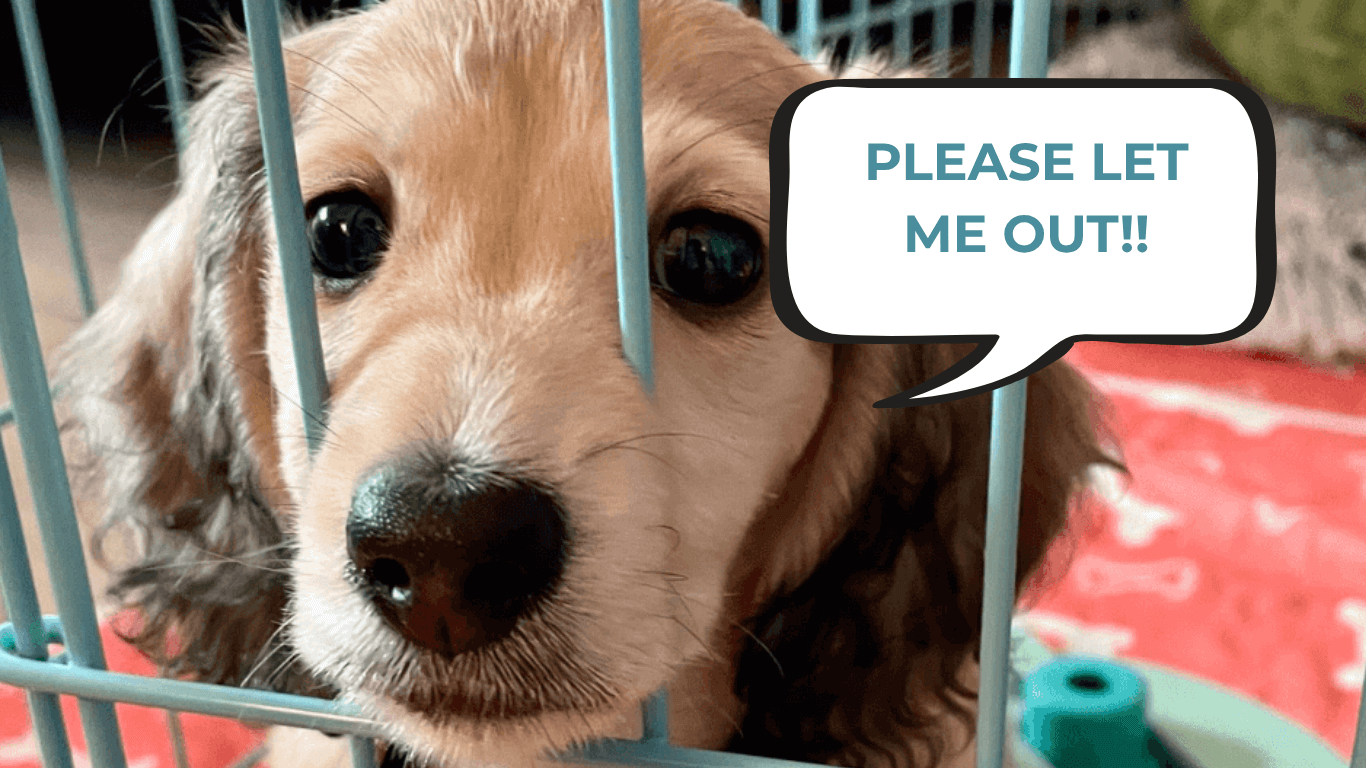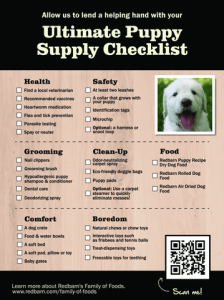Bringing a new puppy home is exciting, but those first few nights can be tough—especially when your puppy cries in the crate. You want to help your furry friend feel safe and comfortable, but it’s hard to know the best way to do it.
What if there was a simple way to calm your puppy and make crate time easier for both of you? You’ll discover practical crate training tips that will stop the crying and build trust. Keep reading to learn how to turn your puppy’s crate into a cozy, happy space they actually want to be in.
Why Puppies Cry In Crates
Puppies often cry when placed in crates. Crying shows they feel upset or uncomfortable.
Understanding why puppies cry helps owners support them better. This guide explains common reasons.
Separation Anxiety
Puppies may cry because they miss their owners. They feel alone and scared without company.
Separation anxiety makes puppies want to be close to people. The crate can feel like a lonely place.
- New environment causes stress
- Missing familiar sounds and smells
- Fear of being left alone
Discomfort And Fear
Puppies may cry if the crate feels uncomfortable. They may fear the crate if it is new or strange.
Unfamiliar spaces can cause fear. Puppies need time to get used to the crate’s size and feel.
- Hard surfaces or small space
- Loud noises nearby
- Darkness or poor ventilation
Need For Attention
Puppies cry to get attention from their owners. They want company and interaction.
Being alone can make puppies feel bored. Crying is their way to ask for play or petting.
- Wanting to play
- Seeking petting or comfort
- Feeling lonely or ignored
Physical Needs
Puppies cry because they need to go outside or are hungry. They use crying to tell owners their needs.
Sometimes puppies cry because they feel cold or are tired. Meeting physical needs helps reduce crying.
- Needing to pee or poop
- Feeling hungry or thirsty
- Being too hot or cold
- Needing rest or sleep

Credit: www.dogsavvylosangeles.com
Choosing The Right Crate
Picking the right crate helps your puppy feel safe and calm. It makes crate training easier, especially if your puppy cries.
Focus on size, comfort, ventilation, safety, and where to place the crate in your home.
Size And Comfort
The crate should be big enough for your puppy to stand, turn, and lie down. Too small makes the puppy uncomfortable. Too large may feel unsafe.
Add a soft bed or blanket to make the crate cozy. Make sure materials are washable and safe for puppies.
- Choose a crate size that fits your puppy’s growth.
- Use soft, washable bedding.
- Check comfort by observing your puppy’s behavior.
Ventilation And Safety
Your puppy needs fresh air inside the crate. Look for crates with good ventilation on all sides. This helps keep the puppy cool and comfortable.
Make sure the crate is safe and sturdy. Avoid crates with sharp edges or loose parts. Check that the door locks securely but is easy to open in emergencies.
- Choose crates with multiple ventilation openings.
- Inspect the crate for sharp edges or broken parts.
- Ensure the door lock is safe and easy to use.
Location In The Home
Place the crate in a quiet spot where the puppy feels safe. Avoid noisy or busy areas that may scare the puppy.
Keep the crate where family members spend time. This helps the puppy feel included and less lonely.
- Choose a quiet, calm corner for the crate.
- Keep the crate near family activity but not in loud spots.
- Avoid direct sunlight or drafts.
Preparing The Crate
Preparing the crate well can help your puppy feel safe. A comfortable crate reduces crying and stress.
Setting up the crate right is the first step to successful crate training. Focus on making it inviting.
Creating A Cozy Space
Make the crate soft and warm with blankets or a small bed. This helps your puppy relax inside.
Choose materials that are easy to clean and safe for puppies to chew on. Avoid anything that can cause choking.
Using Familiar Scents
Place a piece of your clothing in the crate. Your scent comforts your puppy and reduces anxiety.
You can also add a blanket or towel that your puppy already uses. Familiar smells make the crate feel like home.
Adding Toys And Chews
Include safe chew toys to keep your puppy busy. Chewing can calm them and reduce crying.
Soft toys can provide comfort, but choose ones that do not break easily. Rotate toys to keep interest high.
- Safe chew toys help relieve teething pain
- Soft plush toys give a sense of security
- Rotate toys to keep the puppy engaged

Credit: www.dogsavvylosangeles.com
Gradual Crate Introduction
Introducing your puppy to a crate slowly helps reduce crying and stress. It makes the crate a safe and happy place.
Patience and consistency are important during this process. Let the puppy get used to the crate bit by bit.
Short Sessions
Start with very short crate times. Let your puppy explore the crate freely with the door open.
- Place the puppy inside for 2 to 5 minutes.
- Stay nearby and speak softly.
- Open the door and let the puppy leave on its own.
- Repeat several times a day, increasing time slowly.
Positive Associations
Help your puppy link the crate with good things. Use treats, toys, and gentle praise inside the crate.
| Method | Purpose |
| Place treats inside | Encourages puppy to enter |
| Use favorite toys | Makes crate fun |
| Feed meals in crate | Creates comfort and routine |
Reward-based Training
Use rewards to encourage quiet and calm behavior in the crate. Praise and treats work best.
- Give a treat when puppy enters the crate calmly.
- Reward quiet moments inside the crate.
- Avoid opening the crate when the puppy is crying.
- Use a calm voice to reassure your puppy.
Managing Crying And Stress
Crate training a puppy can be challenging. Puppies often cry when they feel stressed. Managing their crying and stress is important for their comfort.
Understanding why your puppy cries helps in easing their anxiety. Here are some tips to manage crying and stress effectively.
Ignoring Attention-seeking Whines
Puppies may cry to get your attention. Ignoring these whines can teach them that crying does not work.
It might be hard, but stay patient. When your puppy stops whining, reward them with attention or treats.
Comforting Without Reinforcing Crying
Comfort your puppy without encouraging crying. Speak softly and offer a favorite toy. Do not pick them up immediately.
Wait for them to calm down first. This teaches them that quiet behavior gets your attention.
Using Calming Aids
Calming aids can help reduce stress in puppies. These include soft music or a ticking clock.
- Play soft music to soothe your puppy
- Use a ticking clock to mimic a heartbeat
- Consider pheromone sprays for calming effects
Establishing A Routine
Crate training a crying puppy requires patience and a clear routine. Puppies feel safer when they know what to expect.
Building a daily schedule helps your puppy get used to the crate and reduces crying over time.
Consistent Crate Times
Set regular times for your puppy to be in the crate. This helps your puppy learn that crate time is normal and not scary.
Try to use the crate at the same times every day, like after meals or before naps. This makes crate time predictable.
- Crate your puppy after eating
- Use the crate before nap times
- Keep crate sessions short at first
Pre-crate Exercise
Give your puppy some exercise before crate time. A tired puppy is more likely to rest quietly.
Play or a short walk can help your puppy burn off energy. This makes crate time calm and peaceful.
- Play fetch for 10-15 minutes
- Take a short walk around the yard
- Let your puppy explore safely before crating
Bedtime Strategies
Make bedtime smooth by following a quiet routine before crating your puppy. This helps your puppy relax and sleep.
Try calming activities like gentle petting or soft talking. Avoid loud noises or excitement before bed.
- Dim the lights 30 minutes before crate time
- Offer a favorite toy or blanket inside the crate
- Stay nearby for a few minutes to comfort your puppy
Troubleshooting Common Issues
Crate training can be tough for puppies who cry. It’s important to understand why your puppy is upset. Here are some tips to help you manage common issues.
Learning the right techniques can make crate training easier for both you and your puppy.
Excessive Crying Solutions
Puppies cry in their crates for many reasons. They might feel lonely or scared. It’s important to help them feel safe and comfortable.
Try giving your puppy a favorite toy or a soft blanket. Make sure the crate is in a quiet, calm area. This can help reduce crying.
- Use treats to encourage quiet behavior
- Play soft music to soothe them
- Gradually increase crate time
Dealing With Nighttime Wake-ups
Nighttime can be hard for puppies in crates. They may wake up often and cry. Creating a bedtime routine can help them sleep better.
Ensure your puppy has had enough exercise during the day. A tired puppy is more likely to sleep through the night.
- Take them out for a potty break before bedtime
- Keep the room dark and quiet
- Use a comfortable bed inside the crate
Adjusting Crate Training For Puppies With Special Needs
Some puppies have special needs that require extra care. This could include health issues or anxiety. Adjust your approach to fit their needs.
Consult your vet for advice on crate training a special needs puppy. They can offer helpful tips and solutions.

Credit: www.dogsavvylosangeles.com
Signs Of Progress And Success
Crate training a puppy can be challenging, especially when they cry. Watching for signs of progress helps you know the training is working. It also shows your puppy feels safer and more comfortable.
Look for changes in your puppy’s behavior. These changes mean they are learning to settle and enjoy their crate time.
Reduced Crying And Anxiety
Your puppy will cry less as they get used to the crate. The anxiety they feel at first will slowly fade. They start to see the crate as a safe place.
- The puppy stops crying soon after being placed in the crate.
- They do not resist entering the crate.
- Less pacing or whining near the crate.
- Calm breathing and relaxed body language.
Self-settling Behavior
Self-settling means the puppy calms down without your help. This skill shows they trust the crate and feel safe alone. They learn to relax and sleep by themselves.
| Behavior | What It Shows |
| Lies down quietly | Comfort in the crate |
| Stops barking or whining | Calmness |
| Chews a toy inside crate | Positive distraction |
| Falls asleep | Relaxation and trust |
Positive Crate Associations
Your puppy will link the crate with good things. This helps them want to go inside happily. Positive associations reduce stress and build a strong bond with the crate.
Signs your puppy likes the crate:
- Walks to the crate on their own
- Wags tail when near the crate
- Eats treats or chews toys inside
- Shows relaxed body language in the crate
Frequently Asked Questions
How Can I Stop My Puppy From Crying In The Crate?
Comfort your puppy with a cozy blanket and a favorite toy. Use positive reinforcement by praising calm behavior. Gradually increase crate time to build comfort and reduce anxiety. Avoid using the crate as punishment to maintain a positive association.
Why Does My Puppy Cry During Crate Training?
Puppies often cry due to separation anxiety, discomfort, or needing to relieve themselves. Crying is their way to communicate stress or discomfort. Understanding the cause helps in addressing their needs and making crate training a positive experience.
When Should I Let My Puppy Out Of The Crate?
Let your puppy out only when they are calm and quiet. This teaches patience and good behavior. Avoid opening the crate during crying episodes to prevent reinforcing the crying habit. Schedule regular breaks for bathroom and playtime.
How Long Should A Puppy Stay In The Crate?
Limit crate time based on age—usually one hour per month of age. Puppies need frequent breaks for bathroom and exercise. Overusing the crate can cause stress, so balance crate time with play and socialization.
Conclusion
Crate training a crying puppy takes time and patience. Stay calm and consistent with your approach. Puppies need to feel safe and loved inside their crate. Use gentle words and comforting tones to ease their stress. Small rewards help build positive habits quickly.
Remember, every puppy learns at their own pace. Trust the process and keep trying each day. Soon, your puppy will enjoy the crate as a cozy space. This creates a happy and well-behaved dog for life.

Emily Barker is the founder of ChillDogLife.com, a space dedicated to helping pup parents discover the best dog products, lifestyle tips, and cozy ideas for happier homes.
A lifelong dog lover, Emily combines her passion for pets with a knack for research to share trusted recommendations on everything from toys and furniture to health and everyday care.
Her goal is simple: to make life easier, stylish, and more joyful for dogs and the people who love them.







